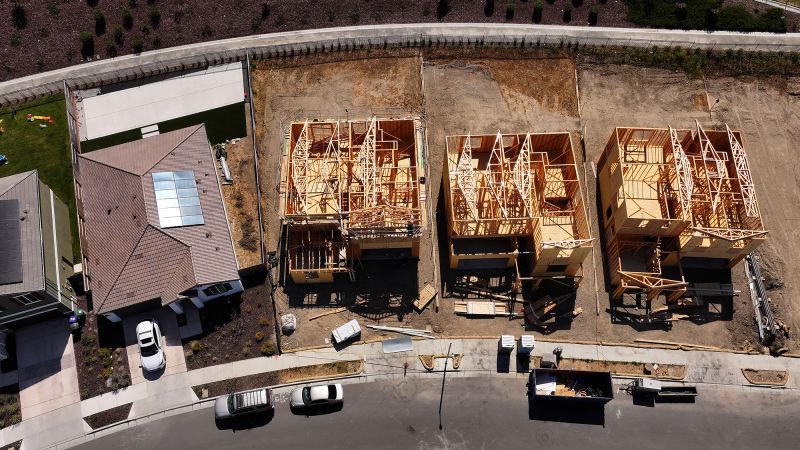Copyright Cable News Network

After five months and more rejected offers than she can remember, Stefanie Campagna was starting to doubt whether she might be able to buy a new home in Rochester, New York. That was until this month, when one seller finally said yes. To get there, Campagna had to pay $100,000 over the asking price, outbidding 36 other offers. Her story is a sign of the times. In today’s housing market, even the lucky ones often face exhausting ordeals and need to stretch their budgets to land a home. In the past few weeks, President Trump has blamed America’s largest homebuilders for the country’s housing affordability woes. In a social media post this month, Trump compared homebuilders to oil cartel OPEC, accusing them of sitting on empty lots to keep home prices artificially high. Economists broadly agree that America’s affordability crisis is rooted in a long-running shortage of homes, a supply problem years in the making. Homebuilding fell dramatically in the years leading up to the 2008 housing crash and never fully recovered. Yet builders and economists say this supply shortage isn’t caused simply by builders sitting on empty lots. They say that building new homes has only gotten harder, slowed by regulation, labor shortages and high financing costs. Some in the industry worry that Trump’s immigration and trade policies will make matters worse. Red tape and local opposition A “perfect storm” of high demand, low supply and mounting costs led to America’s “national housing emergency,” said Shaun Donovan, a former Secretary of Housing and Urban Development during the Obama administration. “I’ve been working in housing for 30 years and I’ve never seen an affordability crisis this bad,” Donovan told CNN. Local zoning and red tape are at the heart of the problem, Donovan, who is currently the CEO of Enterprise Community Partners, said. A study from the National Association of Homebuilders (NAHB) found that nearly 25% of the price of a typical newly built single-family home is due to regulations imposed by state, local and federal governments. The NAHB has lobbied against what it calls “regulatory burdens” around building homes. If land-use regulations were relaxed, an extra 2.5 million more housing units would likely be added over the next decade — eliminating about two-thirds of the estimated housing shortage, according to an analysis by Goldman Sachs. The analysis also noted that large-scale reform would be “challenging” to implement because most regulations are set at the local level. Bureaucracy can slow down projects in places where homes are desperately needed. Oren Amir, founder of Go Home Builders in Los Angeles, said some of his rebuilding projects in Altadena, where residential areas were destroyed by January’s wildfires, have been delayed by conflicting guidance from the city on rooftop solar panel requirements. And the housing shortage has spread beyond coastal cities normally dominated by Democrats to rural areas in Republican strongholds. This has created interesting bedfellows, where politicians on both sides of the aisle increasingly agree that regulations must be streamlined to support supply. For example, California Gov. Gavin Newsom, a Democrat, recently signed a bill that overrides local zoning by allowing for more density near transit stops in some California counties. Montana Gov. Greg Gianforte, a Republican, has also enacted laws aimed at increasing housing supply and cutting red tape. But it’s not only governments that slow projects down. There is often community resistance that stalls the building of homes. That NIMBY, or “not in my back yard,” opposition is driven by a range of concerns, from overcrowding to worries about radically changing the character of communities. NIMBY concerns are a leading obstacle to adding more housing supply, Donovan said. “We’ve got to get communities to understand we’re not talking building skyscrapers,” he said. Trump’s policies may play a role In Rochester, where Campagna lives, these national trends are playing out in real time. Zillow’s Market Heat Index ranks the city among America’s hottest housing markets. Post-pandemic demand and chronic underbuilding in the area have left buyers competing fiercely, often bidding tens of thousands above asking. Campagna compared one open house to an “outdoor concert.” “There were easily more than 100 people there,” she said. But not every part of the country has fallen so far behind demand. In Sun Belt states like Texas and Florida, where some of America’s largest homebuilding companies are concentrated, steady construction in recent years has helped keep home prices in check, and in some cities, even pushed them down. A Texas homebuilding CEO, who requested anonymity over concerns that his comments could draw immigration scrutiny to his job sites, said zoning isn’t a problem in his state, which has no statewide zoning laws. While he broadly supports Trump’s efforts to strengthen border security, the homebuilding CEO told CNN he fears the administration’s intensifying immigration crackdown could backfire and slow down homebuilding by shrinking the already small pool of construction workers. The federal government must have the “courage” to fix the “broken” immigration system, which includes providing a path to allow nonviolent undocumented immigrants to stay in the country and work, said Jim Tobin, CEO of the NAHB. He said the industry wants a visa program for legal immigration for people working in home construction, like the visas common in agriculture and technology. Meanwhile, new tariffs on construction materials like softwood lumber and distribution transformers are also making homebuilding more expensive. Trump’s 10% tariff lumber imports will add $720 to the cost of an average home, while tariffs on kitchen cabinets and vanities will lift costs by roughly $280, according to research from UBS. All told, tariffs are adding about $8,900 to the cost to build an average home, UBS found, noting that builders won’t absorb the entire cost. Fixing the crisis will take time Last month, Treasury Secretary Scott Bessent said Trump was weighing whether to declare a “national housing emergency” this fall to tackle rising home prices. Trump has recently taken aim at America’s largest homebuilders, including Lennar, D.R. Horton and Pulte, accusing them in a social media post of “sitting on 2 million empty lots” and urging them to start building. Homebuilders have more clout than in the past, as the top 16 public homebuilders control about 47% of new construction, compared with 25% in 2013, according to UBS. While America’s largest homebuilders do own millions of empty lots, beginning construction on those lots is more complicated than it seems, said Alan Ratner, a housing analyst at Zelman and Associates. “Homebuilders need to acquire land several years in advance of ever building a house on it. Depending on what type of land they’re acquiring, they might need to build roads and sewers and pipes and get utilities hooked up to that land,” he said. “All of that, of course, is time-consuming. Not to mention getting the projects actually approved by governments to start building houses.” CNN reached out to the 10 largest homebuilders that Trump mentioned in a recent social media post on the subject. None of the companies provided a comment. Ratner said the fact that America’s largest builders own millions of lots signals “they’ve been positioning their businesses for growth.” Donovan, the former Obama official, said he is encouraged by the signal Trump officials are sending to the industry by focusing on supply. “You’re hearing the right words from the administration, but we need to see action that backs it up,” Donovan said. “You don’t solve a housing crisis overnight. It took us years to get into this, and it will take years to get out.”



